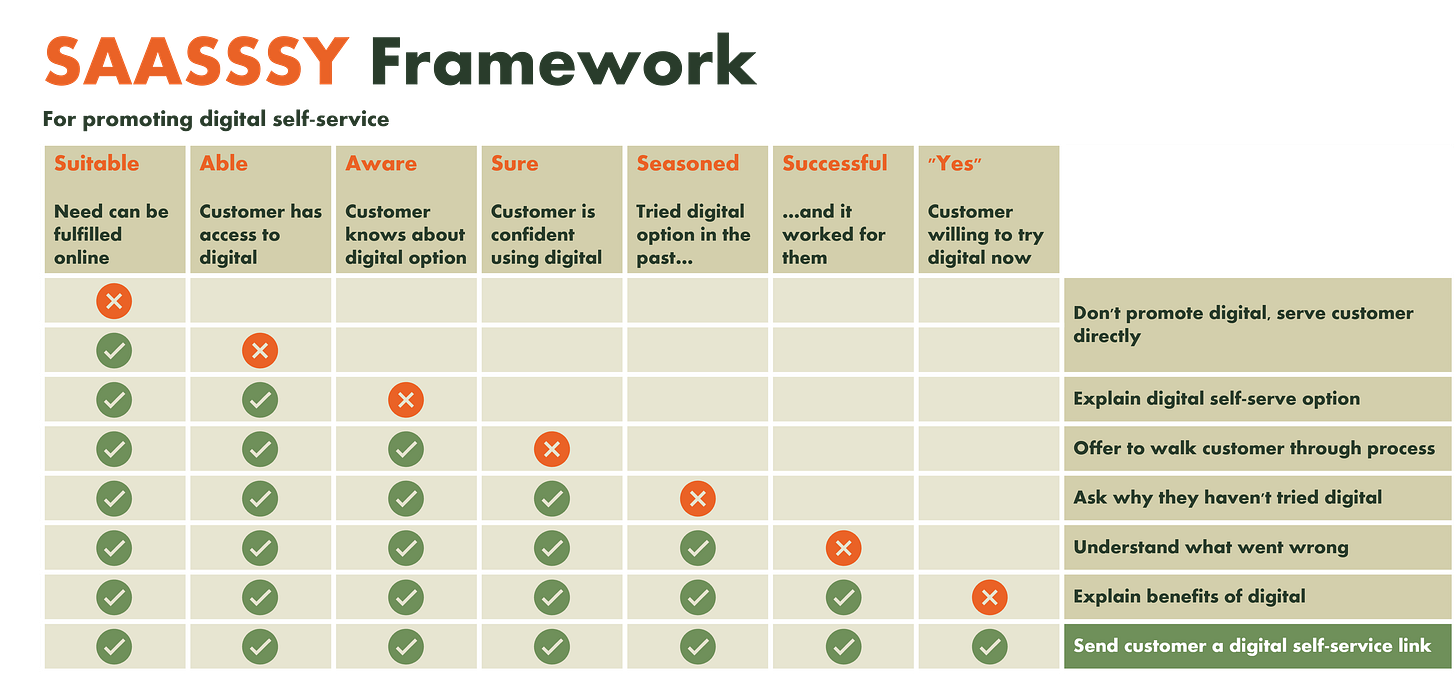This week, Gartner released new research showing that only 40% of Customer Service Representatives (CSRs) promoted digital self-service to customers. I think the implication is that there is 60% of untapped opportunity to get more customers to use digital self-service.
Speaking primarily as a customer, I shudder at the thought of more CSRs promoting digital. It’s hard to think of a process that has been poorly implemented more frequently, or received badly by customers, than getting a CSR to say “Have you tried doing that online?”
The reason becomes clear when we count the fact that for many companies, between 70-95% of customer interactions start online. By blindly promoting self-service to everyone, we are telling most customers to go back to where they started - an obvious trigger for frustration.
But there is one problem we can’t just ignore. Many contact centres still deal with huge volumes of requests from customers that could be handled through self-service. In many cases, self-service is the quicker and more secure option. It is still important for CSRs to encourage customers to go online where relevant.
The SAASSSY framework
Yes, it’s a silly name, but silly names can be easier to remember. More importantly - it works. A few years ago I worked with a telecoms company to come up with an approach to promoting digital self-service in a way that was relevant to each customer. We got SAASSSY…
The framework gets us to ask 7 different questions about a customer’s situation, in a specific order, to decide the best course of action.
1. Is the request SUITABLE for digital self-service?
Of course we need to first find out whether the customer can resolve their actual need themselves. This may not be as obvious as it sounds - we need to check carefully for any exceptions that might prevent self-service from working.
2. Is the customer ABLE to access digital self-service channels?
It’s a shrinking minority - around 5-8% of the population in most developed countries - but some people still don’t have access to digital services. Some companies run community initiatives to increase digital access.
3. Is the customer AWARE that a digital self-service option exists?
Most customers will have some level of awareness that a company offers self-service tools, but many customers still call contact centres out of habit. We need to check that the customer is aware of the digital self-service option for their specific need.
4. Does the customer feel SURE about how to self-serve?
This tends to be one of the bigger points of failure. Customers know about digital self-service, but they don’t feel confident using it. They may worry about data security, or that something might go wrong. If we want these customers to use self-service we will need to walk them through it step by step.
5. Is the customer a SEASONED self-service user?
Has the customer used our self-help before? How much detail do they need to know about how to use self-service? If they are new, will they need to create a login first?
6. …and were they SUCCESSFUL when they last used self-service?
Another common pain point: the customer has tried self-service, but it didn’t work for them. Active listening is needed to understand why the attempt didn’t work and whether it is possible to get things working for the customer.
7. After all that, does the customer say “YES”?
Even if everything else works, we still need to gain customer buy-in. Skilled CSRs learn how to promote digital in a way that is specifically relevant to a customer’s individual needs and concerns.
Putting SAASSSY into practice
The simplest way to adopt the SAASSSY approach is to get CSRs to ask questions to customers in turn, to understand their situation. This works reasonably well, but it can feel clunky, making it hard to keep customers onboard.
The real power comes from using data to provide a personalised suggestion to the CSR on what to offer to a customer. For example: using data which tracks a customer’s app usage can provide information about their most recent experiences with digital self serve. It’s also important to retain and track each customer’s response whenever we do promote digital to them. That way, we can avoid saying the same thing to customers every time they make contact.
There is definitely still opportunity in promoting digital self-service to customers, but it needs to be done thoughtfully and in a way that adapts to each customer’s context. Brute force promotion of digital to every customer will just create frustration.
Recommended news articles
The Recursive: Smart but cold: what AI still can’t do in customer support
Outsource Accelerator: Contact centers face surge in AI, deepfake-driven cyberattacks in 2025
PYMNTS: Klarna promises customers ‘human connection’ amid AI adoption
Glossy: How Benefit is reimagining the customer journey with AI
Fortune: Inside the $400 million Coinbase breach: An Indian call center and teenage hackers
Latest perspectives from BCG
What the return-to-office debate misses: employees are customers
The ongoing debate about return-to-office mandates is a symptom of a bigger issue.
Most companies treat employees as a cost to be managed rather than customers who choose how much of their personal energy and effort to bring to work every day.
Your organization likely knows a lot about customer value: There is also tremendous value to be generated when employees love their work — or to be lost when they are frustrated or exasperated by it.







Love the Saasy Framework, Nick! It's a great matrix for driving the customer to digital in the right way at the right time.